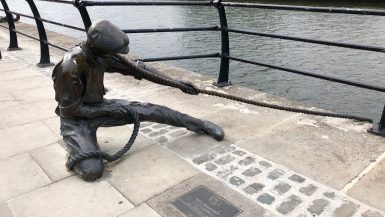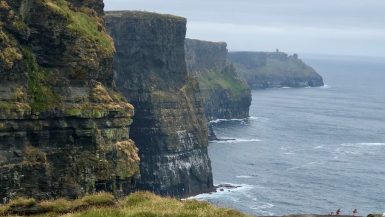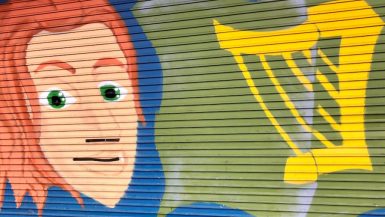July 17, 2018
Train travel is so convenient in Europe. Approximately 2 1/2 hours after the 7 minute walk to Connolly Station, I was in Belfast – all the way up in Northern Ireland. I splurged for First Class, which wasn’t much more expensive, and had a very comfortable seat, wi-fi connection, a private restroom for our car and the option to purchase a full breakfast (not needed since elite status with the hotel had garnered me a free breakfast). I spent the relaxed travel time on my iPad or staring out the window watching the cows and sheep go by.

Off the train, I hit an ATM to pick up pounds sterling to help finance my next few days (Northern Ireland uses the Ulster pounds – interchangeable with the British pound, while the Republic of Ireland uses Euros). I opted to use Uber to get to my hotel. When it became obvious that I hadn’t made it through the maze of hallways, my driver called and guided me through the construction at the station to the pick up area. In the 8 minute taxi ride, he must have called me “love” at least 20 times, but not in a creepy way.
I hadn’t really made any sightseeing plans for my first day, so I took the front desk clerk’s suggestion to take a Black Taxi Tour to get a lay of the land and to also learn the ins and outs of the Troubles. My driver for the 90 minute tour was a young man living in Belfast during the height of the worst of the struggle between Protestant Unionists and Catholic Nationalists. His upbringing was precarious as he had a Protestant father and a Catholic mother. He wanted to present an unbiased narrative of the events, so he wouldn’t tell me on which side of the fence (literally) he was raised until the very end of the tour.
Although religion played a part in the Troubles, which ultimately lasted from 1968 to 1998, politics was really at its heart – whether Northern Ireland would stay a part of the United Kingdom (desire of the Unionists) or become part of the Republic of Ireland (desire of the Nationalists). During the 30 years, more than 3000 people were killed, including many innocents. In one of the bloodiest years, 1972, over 500 people perished. Neighbors fought neighbors and cities and communities were divided. Atrocious acts were performed by members of both sides, although much of the time we only associate the IRA with the most violent acts.

A “peace” wall was built separating the Catholics from the Protestants in the Shankill Road area. The first 20 feet of concrete was extended another 10 feet with corrugated metal and then on top of that a 15 foot height of metal mesh was added so that the wall was high enough to keep someone from lobbing some type of projectile into the other side. Homeowners on either side of the wall further protected their back yards and outdoor spaces by erecting additional metal mesh structures just in case something made it over the wall. Many houses still have these structures as there is still a sense that the conflict has not yet come to an end. To this day, 20 years after the signing of the “Good Friday Peace Accord,” gates separating the two sides are still locked every evening.

Emotions still run high. Each side reveres their “heroes.” In some sections of the city, memorials seem to be on every corner. Murals honoring their heroes, recalling specific horrific events or calling out causes around the world which their “side” backs are everywhere.
You can’t take this kind of tour and not become somewhat emotional. My sadness for the loss of innocent life was intensified as my driver told me a story of how two of his army mates were killed late in the Troubles for being in the wrong place at the wrong time. He did not tip his hand as to what side of the fence he was on until that moment. His buddies were killed by the IRA. He is Protestant, but he tries to stay neutral because his wife is Catholic and they are raising their children Catholic. We agreed that people are people and we all have to learn to live together.

At the end of the tour, I asked to be dropped off at St. Anne’s Cathedral (also known as the Belfast Cathedral). Places of worship always make me emotional and since I was already emotional, I figured I should get my emotion all out at once. Although pretty austere on the outside, the Cathedral has a bounty of beautiful stained glass and mosaics inside.
I particularly liked the memorial window in the Regimental Chapel. Its reflection in the glass surrounding the Chapel of Unity shimmers like water suspended over the alter and the shadows created an almost ghostly peace symbol.

One of the most emotional pieces for me was the Titanic Pall, a memorial to the people who died when the RMS Titanic sank on its maiden voyage in April 1912. On merino felt died indigo to represent water, the designers hand embroidered 1517 Crosses, Stars of David and Crescents commemorating each of the people who perished that day. The size and scope of the piece brings to heart how many lives were lost in that catastrophe.
So after a full day of emotion, I just started walking the streets around the Cathedral Quarter and the Harbour in search of some of the street art for which Belfast is known. It added a bit of levity to an otherwise deep day.
After a dinner of bbq rotisserie chicken (nope, not even close to Texas barbecue), I headed back toward my hotel. I had been given directions earlier by the front desk clerk to find the “blue fish” and then look up; I would see the hotel. She said I would know it when I saw it… and I did.




















